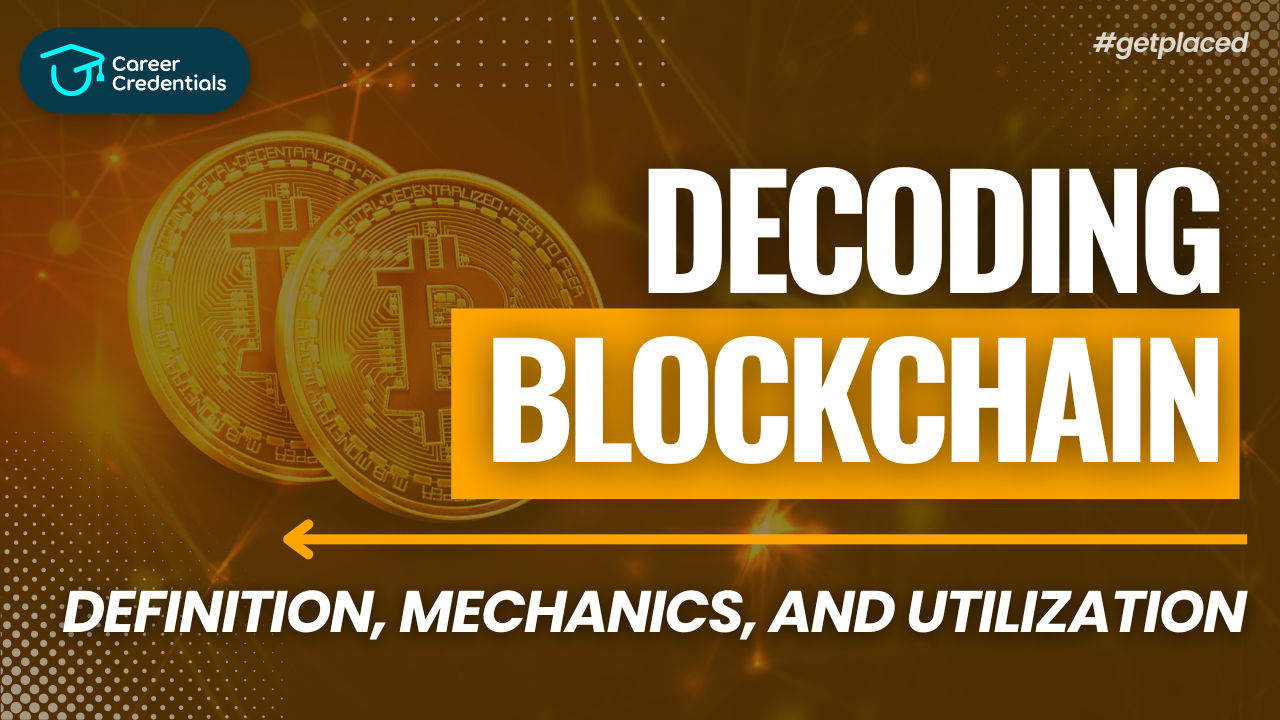Decoding Blockchain: Definition, Mechanics, and Utilization

Blockchain is like a digital ledger that keeps records of transactions, but it's not stored in one place. Instead, it's spread out across many computers, making it more secure.
In this guide, we'll break down blockchain into easy-to-understand parts. We'll explain what it is, how it operates, and where it's being used. From understanding the basics to exploring real-world applications, let's dive into the world of blockchain and discover its impact on our digital future.
Learn Now: Introduction to Blockchain for Beginners by Dr. Amar Panchal for FREE!!
Understanding Blockchain: A Primer
Blockchain, at its essence, serves as a decentralized ledger that facilitates the secure recording and sharing of data across a network of nodes. This innovative technology differs significantly from traditional databases, offering immutability and transparency.
By structuring data into blocks that are cryptographically linked, blockchain ensures that once information is recorded, it cannot be altered or deleted without consensus from the network. This foundational principle of blockchain underpins its diverse applications across various industries.
Mechanics of Blockchain: How It Works
The mechanics of blockchain operation revolve around its decentralized architecture and consensus mechanisms. When a transaction occurs, it is broadcast to the network, where it undergoes validation by multiple nodes.
This validation process, often referred to as mining or validation, ensures the integrity of transactions and prevents double-spending. Once validated, the transaction is added to a block, which is then appended to the existing chain.
The cryptographic linking of blocks ensures the immutability of the ledger, while consensus mechanisms such as proof of work or proof of stake maintain the security and integrity of the network.
Check Out: SQL Roadmap by Career Credentials for FREE !!
Applications of Blockchain: Beyond Cryptocurrency
While blockchain initially gained prominence through its association with cryptocurrencies, its potential applications extend far beyond financial transactions. In supply chain management, blockchain can revolutionize transparency and traceability by securely recording the journey of products from origin to consumer.
Similarly, in healthcare, blockchain-based systems can securely store and manage patient records, ensuring privacy, security, and interoperability. Moreover, blockchain holds promise in sectors such as identity verification, voting systems, and intellectual property management, where trust, transparency, and security are paramount.
Blockchain in Finance: Revolutionizing Banking and Payments
In the realm of finance, blockchain technology has the potential to revolutionize banking and payment systems by offering faster, more secure, and cost-effective transactions. Blockchain-based platforms enable peer-to-peer transfers, eliminating the need for intermediaries and reducing transaction fees.
Additionally, smart contracts deployed on blockchain networks automate contractual agreements, streamlining processes such as loan approvals, insurance claims, and trade finance. With its ability to enhance transparency, efficiency, and security, blockchain is poised to transform traditional financial infrastructure and empower individuals worldwide.
Check Out: Practice Questions on C++ by Career Credentials for FREE !!
Addressing Challenges and Limitations
Despite its transformative potential, blockchain technology faces several challenges and limitations that hinder widespread adoption. Issues such as scalability, energy consumption, and regulatory uncertainty pose significant hurdles to its implementation.
Scalability remains a concern as blockchain networks struggle to handle increasing transaction volumes without sacrificing speed or security. Additionally, the energy-intensive consensus mechanisms employed by some blockchains raise environmental concerns and contribute to centralization.
Regulatory ambiguity further complicates the adoption of blockchain technology, with varying legal frameworks and compliance requirements across jurisdictions. However, ongoing research and development efforts are focused on addressing these challenges through innovations such as scalability solutions, consensus algorithm improvements, and regulatory clarity initiatives.
Conclusion
In conclusion, blockchain represents a transformative force that has the potential to reshape industries, empower individuals, and foster trust in digital interactions. By understanding its underlying principles, exploring its diverse applications, and addressing its challenges, we can harness the full potential of blockchain to create a more secure, transparent, and efficient future for all.
As we continue to unlock new possibilities and overcome obstacles, the blockchain revolution is poised to usher in a new era of innovation, collaboration, and prosperity. It is imperative that stakeholders across industries collaborate to leverage blockchain technology responsibly and ethically, driving positive change and advancing towards a decentralized and inclusive future.
Enroll Now: Learn Django with Prashant Sir and master web development effortlessly!
Confused About Your Career?
Don't let another opportunity pass you by. Invest in yourself and your future today! Click the button below to schedule a consultation and take the first step towards achieving your career goals.
Our team is ready to guide you on the best credentialing options for your aspirations.
Let's build a brighter future together!
Empower Yourself. Elevate Your Career at Career Credentials Where Education meets Ambition.
